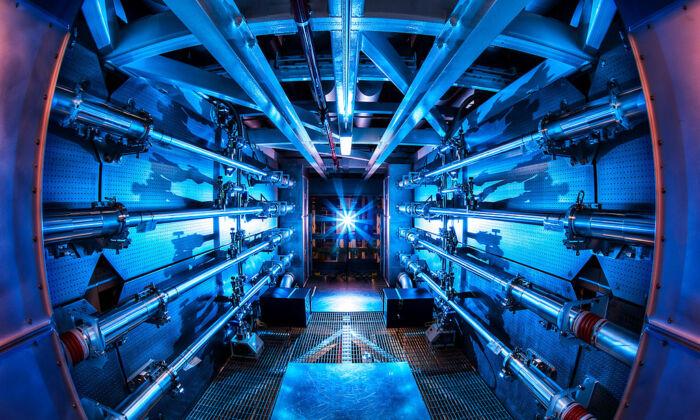The most powerful laser beam ever created has been recently fired at Osaka University in Japan, where the Laser for Fast Ignition Experiments (LFEX) has been boosted to produce a beam with a peak power of 2,000 trillion watts—two petawatts—for an incredibly short duration, approximately a trillionth of a second or one picosecond.
Values this large are difficult to grasp, but we can think of it as a billion times more powerful than a typical stadium floodlight or as the overall power of all of the sun’s solar energy that falls on London. Imagine focusing all that solar power onto a surface as wide as a human hair for the duration of a trillionth of a second: that’s essentially the LFEX laser.
LFEX is only one of a series of ultra-high power lasers that are being built across the world, ranging from the gigantic 192-beam National Ignition Facility in California, to the CoReLS laser in South Korea, and the Vulcan laser at the Rutherford Appleton Laboratory outside Oxford, U.K., to mention but a few.
There are other projects in design stages—of which the most ambitious is probably the Extreme Light Infrastructure, an international collaboration based in Eastern Europe devoted to building a laser 10 times more powerful even than the LFEX.
So what is driving scientists all over the world to build these jewels of optical and electronic technology? What is enough to convince politicians to allocate such significant research funds to back these enormous projects?
Recreating the Early Universe
Well, the first reason that comes to mind is because the “wow factor” that is associated with lasers. But there’s a whole lot more than just exciting scientists’ and enthusiasts’ imagination.
Lasers this powerful are the only means we have to recreate the extreme environments found in space, such as in the atmosphere of stars—including our sun—or in the core of giant planets such as Jupiter. When these ultra-powerful lasers are fired at ordinary matter it is instantaneously vaporized, leading to an extremely hot and dense ionized gas, which scientists call a plasma. This extreme state of matter is extremely rare on Earth, but very common in space—almost 99 percent of ordinary matter in the universe is believed to be in a plasma state.
Ultra-powerful lasers allow us to create a small replica of these extreme states and objects from the universe in such a way that they can be studied in a controlled manner in the laboratory. In a way, they allow us to travel back in time, since they can recreate the conditions found in the early universe, moments after the Big Bang. These extremely dense and hot environments, which only ultra-powerful lasers can create, have already taught us a lot about the evolution of our universe and its current state.
Uses Closer to Home
On a more practical note, laser facilities are not only interesting for their input into theoretical research, they’re also at the core of crucial practical applications. For example, current research into alternative and clean energy generation or health care. The LFEX mainly applies to the former, since it is built to study nuclear fusion research.
Unlike nuclear fission, nuclear fusion does not generate radioactive waste. This means fusion fuels are much easier to store and handle—we can use seawater and lithium, somewhat handier and easier to come by than uranium.
Nuclear fusion is what creates and sustains the immense energy of stars, but it requires a significant input of power to initiate the chain reaction. High-powered lasers such as LFEX are the best candidates for the job. In fact preliminary results are encouraging, with a test at the U.S. National Ignition Facility managing to generate more energy than it expended on one occasion last year.
Inexpensive Particle Research
This class of ultra-powerful lasers is also extremely appealing because it represents a much more compact and inexpensive (by comparison) alternative to the huge particle accelerators such as at CERN—which measure many kilometers in length. High-powered, laser-driven particle accelerators can generate ultra-high quality x-rays without the need to use radioisotope particles, which need careful handling. These laser-driven x-rays can then be used for taking high-resolution images of biological tissues in a really compact and inexpensive system. For example, this laser-driven tomography of an insect.
Researchers are also now working on using laser-driven ion beams for cancer therapy. This technique has so far been restricted due to the cost and size of conventional accelerators. Laser-based cancer therapy would be affordable to a much larger number of hospitals, bringing this effective cancer therapy technique to a much larger number of patients.
So the ultra-high power that LFEX can deliver, if only for the briefest of moments, is not just a fancy new toy but an exciting step forward in applying laser technology to a wider range of disciplines—from the the seemingly abstract world of the early universe, to the very real uses providing the tools to diagnose disease or fight cancer.
Gianluca Sarri is a lecturer at the School of Mathematics and Physics at Queen’s University Belfast in the U.K. This article was originally published on TheConversation.com

